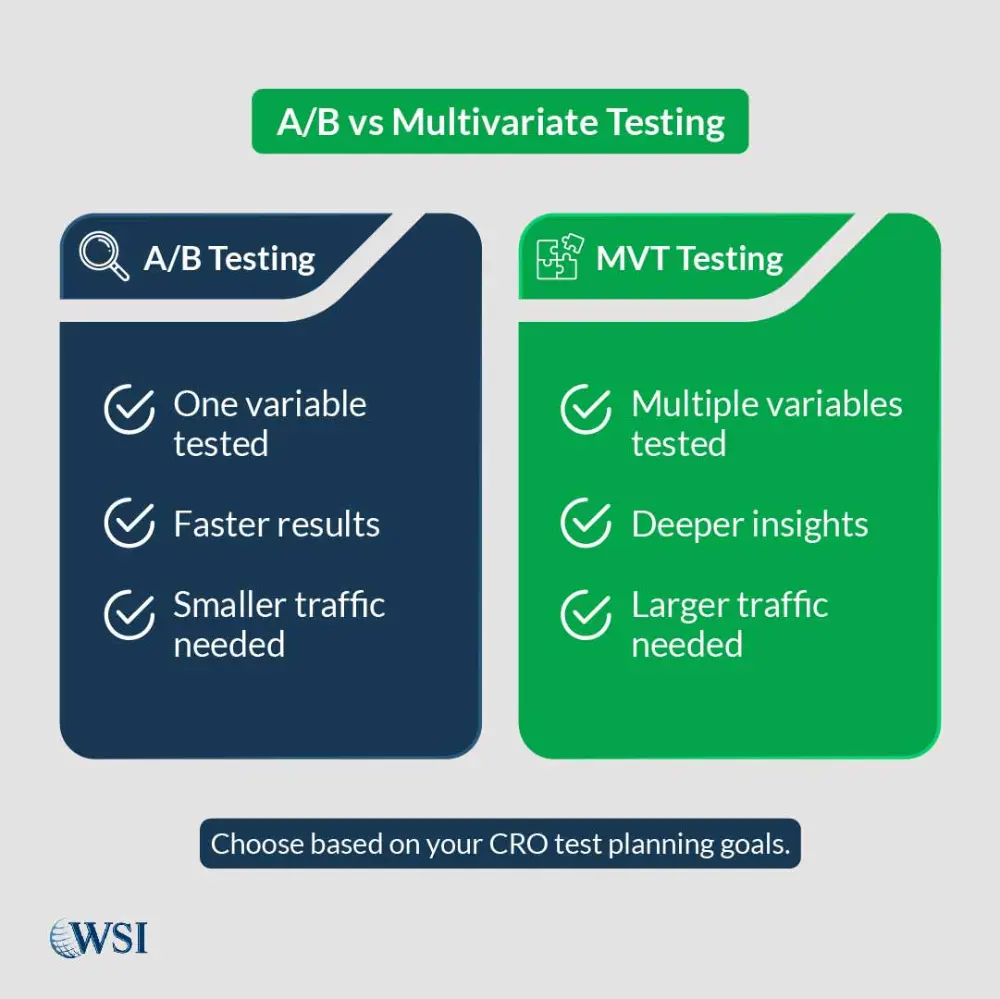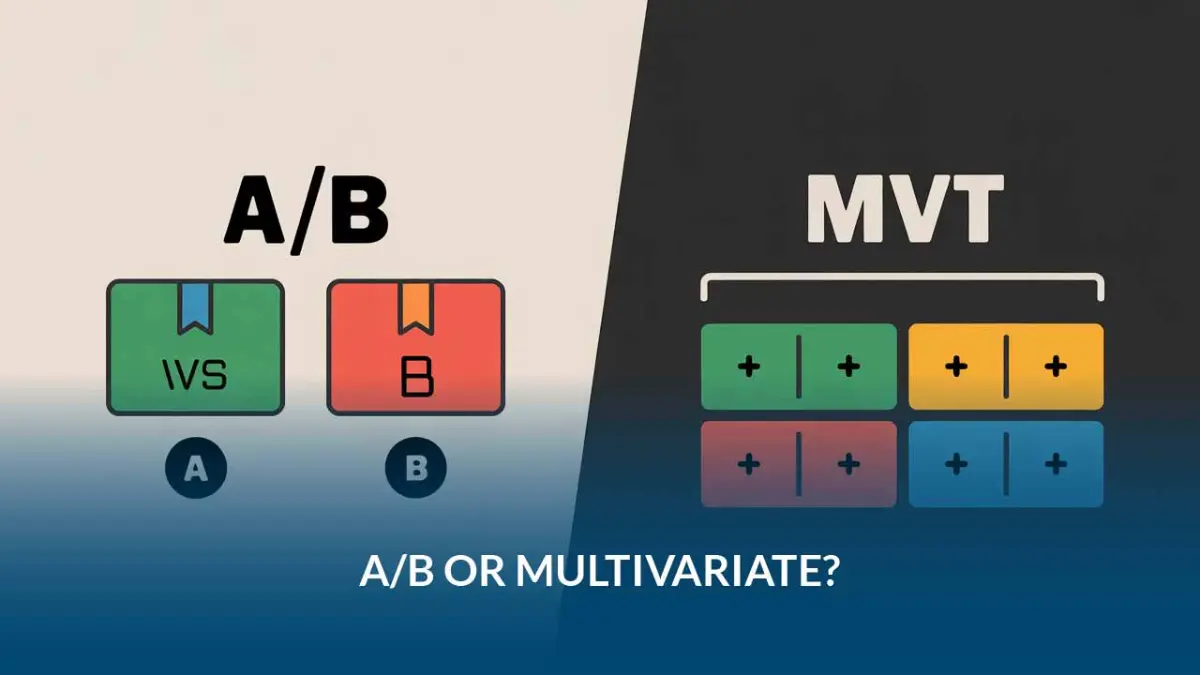A/B vs multivariate testing comes down to scope, speed, and strategy. If you want quick answers to simple questions, A/B testing gives you clarity. If you need to measure how multiple changes interact, multivariate testing digs deeper. Both methods matter because they let you optimize website elements with real data instead of guesswork.
Key Takeaways:
- A/B testing is best for single-variable clarity, multivariate testing for complex combinations.
- Sample size, test duration, and statistical method shape reliability.
- Smart CRO test planning avoids wasted effort and accelerates ROI.
Contents
- 1 What Is A/B Testing and How Does It Work?
- 2 A/B vs. Multivariate: Key Differences and Use Cases
- 3 How to Choose the Right Testing Method
- 4 The Role of Bayesian vs. Frequentist Approaches
- 5 Testing Duration, Sample Size, and Reliability
- 6 Pitfalls to Avoid: Common Testing Mistakes
- 7 Case Scenarios: When to Scale From A/B to MVT
What Is A/B Testing and How Does It Work?
A/B testing is the classic conversion experiment. You show version A to one group of visitors and version B to another. The only difference is a single change, such as a headline, button color, or form layout. By isolating one factor, you get clear feedback on which variation drives higher conversions.
Practical A/B testing examples include:
- Comparing “Sign Up Free” vs. “Get Started Now” on a call-to-action button.
- Testing two different hero images on a product landing page.
- Switching from a single-step form to a two-step form.
A/B testing shines when you need fast feedback on specific elements. It also works when your traffic is modest because the experiment requires fewer participants to produce meaningful data. In CRO test planning, A/B testing is often the first step to identify easy wins before moving into more complex experiments.
What Is Multivariate Testing (MVT)?
Multivariate testing goes further. Instead of testing just one element, you test several at once. The goal is to see how different combinations of changes influence conversions. You’re not just asking “which headline works better?” You’re asking “which headline paired with which image and which button text performs best?”
This method is powerful for experienced marketers who want a complete multivariate test strategy. For example, you could test three headlines, two hero images, and two call-to-action buttons all at once. That creates twelve possible combinations. Each variation shows how multiple changes interact to influence user behavior.
The tradeoff? You need high traffic to run MVT effectively. Each variation requires enough visitors to achieve statistical confidence. That means multivariate testing is better suited to established websites with steady traffic and clear CRO goals.
A/B vs. Multivariate: Key Differences and Use Cases

A/B vs multivariate testing differs in complexity, purpose, and timing. A/B answers narrow questions about one variable, while multivariate testing explores interactions between multiple variables. A/B works for quick insights. MVT reveals deeper patterns once you’re ready to optimize website elements at scale.
Comparison Table: A/B vs. Multivariate Testing
| Factor | A/B Testing | Multivariate Testing |
| Variables Tested | One at a time | Multiple simultaneously |
| Traffic Requirement | Lower | Higher |
| Speed of Results | Faster | Slower |
| Insights Provided | Clear cause-and-effect | Interaction effects among elements |
| Best Use Cases | Early-stage CRO, small optimizations | Advanced CRO, large-scale campaigns |
When should you use A/B testing? Early in the buyer journey, when you want to test simple changes. For example, swapping call-to-action text or trying different layouts.
When should you use multivariate testing? Later, when your team already has baseline data and you want to refine the entire funnel. A strong multivariate test strategy allows you to uncover synergies between design, copy, and user flow.
How to Choose the Right Testing Method
Choosing between test types requires clarity on goals, traffic, and resources.
- If your goal is to validate one change, go with A/B testing.
- If your aim is to measure how several factors combine, move to MVT.
- If your traffic is limited, start small and expand later.
- If you have high-volume traffic and patience for longer experiments, MVT unlocks broader insights.
Think of conversion test types as tools in a kit. A/B testing is the hammer, simple, reliable, and quick. Multivariate testing is the full toolkit, more complex, yet more versatile when used properly.
The Role of Bayesian vs. Frequentist Approaches
Bayesian and Frequentist approaches are two statistical philosophies used to interpret testing results. A/B vs multivariate testing can rely on either method, and your choice affects how quickly you act on data.
Comparison Table: Bayesian vs. Frequentist
| Factor | Frequentist Approach | Bayesian Approach |
| Core Principle | Probability based on long-run frequency | Probability updated with new evidence |
| Test Duration | Often longer | Often shorter |
| Practical Outcome | Wait for statistical significance | Continuous updates as data flows in |
| Best Use Cases | Academic rigor, large datasets | Fast-moving CRO, business decisions |
A Frequentist approach works like a courtroom, it waits for overwhelming evidence before declaring a winner. Bayesian acts more like a coach, it updates predictions in real time and adjusts as new results roll in. Both can serve CRO test planning, yet most marketers prefer Bayesian for its speed and business practicality.

Want results you can trust?
Bayesian and Frequentist both offer value. The right choice depends on your goals, data size, and tolerance for speed vs. certainty.
Testing Duration, Sample Size, and Reliability
Every test relies on three factors: duration, sample size, and reliability.
- Duration: Too short, and your results are random. Too long, and you waste opportunities.
- Sample Size: A/B testing needs fewer visitors. MVT divides traffic into more groups, which raises requirements.
- Reliability: Without statistical confidence, you risk chasing false positives.
The art lies in balance. Run your test long enough to capture natural traffic fluctuations across weekdays, weekends, and campaigns. Aim for statistical confidence above 90%. Anything less, and you risk implementing changes that don’t really work.
Pitfalls to Avoid: Common Testing Mistakes
Even seasoned marketers fall into traps:
- Testing too many variables at once with low traffic. Results become meaningless without enough data.
- Stopping tests early. Short tests often exaggerate outcomes.
- Ignoring external factors. Seasonality, paid campaigns, and even site outages skew results.
- Failing to segment audiences. A winning variation for desktop users may fail on mobile.
Avoid these mistakes through structured CRO test planning. Think of it like building a flight plan before takeoff. Without it, your campaign risks turbulence.

Ready to avoid wasted tests?
Eliminate false positives. Gain clarity. Build reliable testing practices that grow revenue.
Case Scenarios: When to Scale From A/B to MVT
Imagine you’ve tested several A/B variations and gained confidence in your conversion funnel. You know which headlines work, which buttons attract clicks, and which forms reduce drop-offs. That’s when you graduate to multivariate testing.
Examples of scaling include:
- You’ve run multiple A/B testing examples and see diminishing returns.
- You have consistent, high-volume traffic and can divide visitors across many test cells.
- You want to measure how headline, image, and call-to-action interact, not just one at a time.
Think of A/B as learning to sprint. Once you’ve mastered sprints, multivariate testing helps you run a marathon with strategy. The key is knowing when your business is ready for that shift.
A/B vs multivariate testing is not a debate of one method replacing the other. Instead, it’s about choosing the right tool at the right time. Use A/B testing for quick wins and low-traffic environments. Use multivariate testing when your site has matured and your data volume supports more advanced insights.
Both methods are cornerstones of conversion optimization. With disciplined CRO test planning, reliable data interpretation, and a willingness to test continuously, you can optimize website elements with confidence. Start simple, scale smart, and let testing drive measurable growth.

Ready to scale your testing strategy?
Move from single-variable insights to comprehensive optimization. Learn when to make the leap to MVT.

